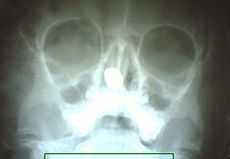Rhinolith
| Rhinolith | |
|---|---|
 Xray of paranasal sinuses showing rhinolith | |
| Classification and external resources | |
| ICD-10 | J34.8 |
| ICD-9 | 478.19 |
A rhinolith is a calculus present in the nasal cavity. The word is derived from the roots rhino- and -lith, literally meaning "nose stone". It is an uncommon medical phenomenon, not to be confused with dried nasal mucus. A rhinolith usually forms around the nucleus of a small exogenous foreign body, blood clot or secretion by slow deposition of calcium and magnesium salts. Over a period of time, they grow into large irregular masses that fill the nasal cavity. They may cause pressure necrosis of the nasal septum or lateral wall of nose. Rhinoliths can cause nasal obstruction, epistaxis, headache, sinusitis and epiphora.[1][2]
Clinical features
Rhinoliths present as unilateral nasal obstruction. Foul-smelling, blood-stained discharge is often present. Epistaxis and pain may occur due to the ulceration of surrounding mucosa.
References
- ↑ "American Heritage Dictionary". Houghton Mifflin Company. 2004. Retrieved on December 10, 2006.
- ↑ Ghorayeb, Bechara (October 21, 2006). "Pictures of Rhinolith (Nasal Calculus)". Retrieved on December 10, 2006.
| ||||||||||||||||||||||||||||||||||||||||||||||||||||||||||||||||||||||||||||||||||||